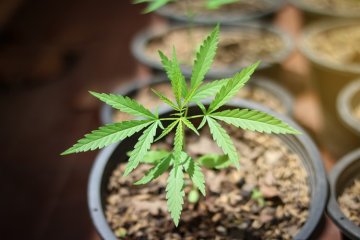THCJD: On the origin, properties and effects of a new cannabinoid

- What is THCJD?
- What does THCJD look like?
- What are the effects of THCJD?
- Is THCJD legal?
- THCJD: What is on the market?
- Conclusion
What is THCJD?
THCJD, or tetrahydrocannabidiol, is a cannabinoid found in small amounts in the cannabis plant. According to available sources, it is not a new compound. Roger Adams discovered a substance with this structure in the 1940s, which is why, in addition to THCJD, you may also see THC-Octyl and THC-C8 or JWH-138 in some scientific articles. However, in brick-and-mortar stores and e-shops, products with this compound are sold exclusively under the name THCJD.
As direct extraction from the cannabis plant is difficult and uneconomical, THCJD is produced from more readily available precursors, such as CBD isolate.
What does THCJD look like?
THCJD is similar in chemical structure to the well-known psychoactive cannabinoid THC, but has a longer alkyl chain. THC's side chain consists of five carbons, THCJD's of eight, and we know that even a slight difference in chemical structure can significantly affect and change the properties and effects of a compound.
THCJD's extended side chain suggests a greater affinity for endocannabinoid receptors, particularly CB1 receptors in the brain, which may explain its alleged high potency. The longer the side chain, the higher the potency of the cannabinoid.
What are the effects of THCJD?
Although no scientific studies have been published on THCJD, the experience of users shows that it appears to have strong psychoactive properties. It could induce euphoria or contribute to relaxation.
As for the duration of the effects, 1-4 hours has been reported, but this is a highly individual matter, depending, among other things, on the type of product, the method of use, gender, age, sensitivity or metabolism of the individual.
Like many other cannabinoids, THCJD can cause side effects such as:
- dry mouth
- red eyes
- impaired coordination
- increased heart rate
- memory problems
- anxiety
- paranoia
- vomiting
- tremors
THCJD is not a cannabinoid for 'beginners', and certain groups of people, such as those with psychotic or cardiovascular disorders or pregnant or breastfeeding women, should avoid THCJD altogether because of the potential for serious side effects.
We do not yet have information on the possible risks and long-term effects, so THCJD should be treated with the utmost caution.

Is THCJD legal?
The legal status of THCJD is currently ambiguous. Most commercial products available contain less than 0.2 or 0.3 % THC and from this point of view THCJD is therefore considered 'legal' in many countries or falls into the so-called 'grey area'.
If you are wondering whether or not THCJD is legal in a particular country, always check the current laws and regulations of that country. Be aware that cannabis laws are constantly evolving and, especially in the case of new cannabinoids, can change very quickly. As of 3 April 2024, THCJD is banned in Bulgaria, Latvia, the UK and Malta.
THCJD: What is on the market?
Despite the uncertainties about the effects and risks of THCJD, a large number of products are already on the market in the United States, the Netherlands, Austria and other countries, such as:
- THCJD vape foams and cartridges
- Gummies
- Tinctures
- Hash
- Pre-rolls
- Flowers with THCJD distillate
These products come in a variety of concentrations and flavours, some combining THCJD with other cannabinoids such as THCH, THCA or CBD.
Conclusion
THCJD is of considerable interest to users because of its potential potency and the mystery surrounding it. Even though it is not currently on the list of banned or dangerous substances in most countries, there are no scientific studies yet mapping the effects and risks.
Unless the products come from reliable manufacturers and are laboratory tested, they risk being contaminated with undesirable substances such as heavy metals or solvents.
Even if you are able to obtain THCJD products from trusted manufacturers/vendors, consider all risks and beware of dosage before deciding to buy and use this cannabinoid.
Original text: Michaela Mádlová, translation by AI
Photo: Shutterstock
"All information provided on this website, as well as the information provided through this website, is for educational purposes only. None of the information contained herein is intended as a substitute for medical diagnosis and such information is not to be considered medical advice or recommended treatment. This website does not promote, endorse or advocate the legal or illegal use of narcotic drugs or psychotropic substances or the commission of any other illegal activity. Please see our Disclaimer for further information.“
